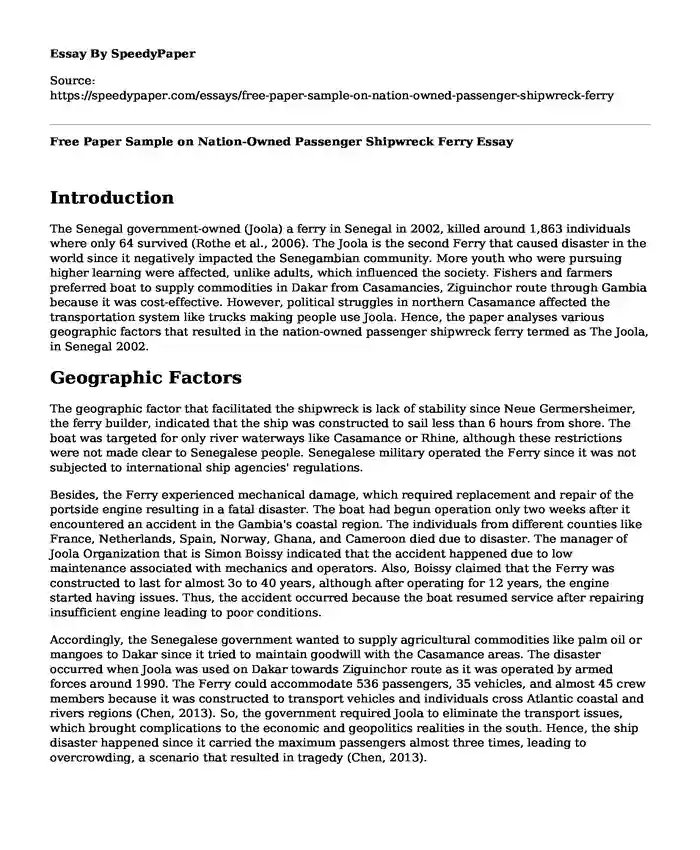
| Type of paper: | Essay |
| Categories: | Geography Government World Social issue |
| Pages: | 3 |
| Wordcount: | 721 words |
Introduction
The Senegal government-owned (Joola) a ferry in Senegal in 2002, killed around 1,863 individuals where only 64 survived (Rothe et al., 2006). The Joola is the second Ferry that caused disaster in the world since it negatively impacted the Senegambian community. More youth who were pursuing higher learning were affected, unlike adults, which influenced the society. Fishers and farmers preferred boat to supply commodities in Dakar from Casamancies, Ziguinchor route through Gambia because it was cost-effective. However, political struggles in northern Casamance affected the transportation system like trucks making people use Joola. Hence, the paper analyses various geographic factors that resulted in the nation-owned passenger shipwreck ferry termed as The Joola, in Senegal 2002.
Geographic Factors
The geographic factor that facilitated the shipwreck is lack of stability since Neue Germersheimer, the ferry builder, indicated that the ship was constructed to sail less than 6 hours from shore. The boat was targeted for only river waterways like Casamance or Rhine, although these restrictions were not made clear to Senegalese people. Senegalese military operated the Ferry since it was not subjected to international ship agencies' regulations.
Besides, the Ferry experienced mechanical damage, which required replacement and repair of the portside engine resulting in a fatal disaster. The boat had begun operation only two weeks after it encountered an accident in the Gambia's coastal region. The individuals from different counties like France, Netherlands, Spain, Norway, Ghana, and Cameroon died due to disaster. The manager of Joola Organization that is Simon Boissy indicated that the accident happened due to low maintenance associated with mechanics and operators. Also, Boissy claimed that the Ferry was constructed to last for almost 3o to 40 years, although after operating for 12 years, the engine started having issues. Thus, the accident occurred because the boat resumed service after repairing insufficient engine leading to poor conditions.
Accordingly, the Senegalese government wanted to supply agricultural commodities like palm oil or mangoes to Dakar since it tried to maintain goodwill with the Casamance areas. The disaster occurred when Joola was used on Dakar towards Ziguinchor route as it was operated by armed forces around 1990. The Ferry could accommodate 536 passengers, 35 vehicles, and almost 45 crew members because it was constructed to transport vehicles and individuals cross Atlantic coastal and rivers regions (Chen, 2013). So, the government required Joola to eliminate the transport issues, which brought complications to the economic and geopolitics realities in the south. Hence, the ship disaster happened since it carried the maximum passengers almost three times, leading to overcrowding, a scenario that resulted in tragedy (Chen, 2013).
Corruption
Moreover, the evidence argued that corruption and lack of transparency made the boat officials to allow non-ticket people to board the ship. According to Transparency International reports of 2002, around 75 million individuals have been paying bribes in Sub-Saharan Africa to acquire services every day (Beizsley, 2019). Before the ferry disaster, leaders like Abdoulaye Wade, the president, were charged with the scandal of misusing and embezzling public funds associated with the transportation sector's bribes. Thus, the most geographical factors that cause the Joola disaster is overcrowding because the storms move significantly in the Senegambial coast, which facilitated shipwreck.
Conclusion
In conclusion, various geographical factors played a part in the shipwreck of Senegal 2002, such as overloading where President Wade argued that the boat carried over maximum capacity and supported the resignations of two leaders linked with tragedy. Other evidence indicates that the ship disaster occurred due to corruption and lack of transparency among the political leaders. They imposed high tariffs on truck operators, making people prefer to ship, leading to overcrowding. Therefore, the massive loss of lives was a shock to Senegal society, making the government begin investigation through collaborating with the public and press.
References
Beizsley, D. J. (2019). State-corporate crime reconsidered: A criminological case study of European Investment Bank lending in the EU (Doctoral dissertation, Utrecht University). https://dspace.library.uu.nl/bitstream/handle/1874/385617/Utrecht_final_version.pdf?sequence=4&isAllowed=y
Chen, J. Y. (2013). Migration as a Strategy of" Authentic" Development? The Case of Senegal (Doctoral dissertation, Howard University). https://www.academia.edu/8369327/Migration_as_a_Strategy_of_Authentic_Development_The_Case_of_Senegal
Rothe, D., Muzzatti, S., & Mullins, C. W. (2006). Crime on the high seas: Crimes of globalization and the sinking of the Senegalese Ferry Le Joola. Critical Criminology, 14(2), 159-180.
https://doi.org/10.1007/s10612-006-9003-3.
Cite this page
Free Paper Sample on Nation-Owned Passenger Shipwreck Ferry. (2023, Nov 24). Retrieved from https://speedypaper.com/essays/free-paper-sample-on-nation-owned-passenger-shipwreck-ferry
Request Removal
If you are the original author of this essay and no longer wish to have it published on the SpeedyPaper website, please click below to request its removal:
- Post Laboratory Questions - Chemistry Essay Example
- Essay Sample on Prison Cultures for Free Download
- Free Essay on Capital Punishment
- The Geology of Yosemite, Free Essay for Your Inspiration
- Paper Example. Immigration Into the United States
- Free Essay. Death with Dignity and Green Burial
- Essay Sample on Asian American History - Asiatic Exclusion League
Popular categories




